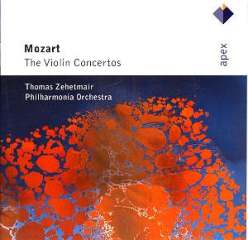Mozart – Violin Concertos (Zehetmair) [2007]
Mozart – Violin Concertos (Zehetmair) [2007]

CD 1 Violin Concerto No. 1 in B flat major, K207 (c.1773) [19:37] Violin Concerto No. 2 in D major, K211 (1775) [17:56] Violin Concerto No. 3 in G major, K216 Strassburg (1775) [21:45] CD 2 Violin Concerto No. 4 in D major, K218 (1775) [21:18] Violin Concerto No. 5 in A major, K219 Turkish (1775) [26:02] Violin Concerto in D major, K271a (c.1775-77) [25:52] Philharmonia Orchestra Thomas Zehetmair – violinist, conductor
Salzburg-born violin virtuoso Thomas Zehetmair won prestigious awards in 1997 for his 1995 Birmingham recording of the Szymanowski Violin Concertos with the CBSO under Sir Simon Rattle on EMI Classics 5577772. Great acclaim was accorded to Zehetmair’s outstanding 2001 Propstei St. Gerold recording of the Eugène Ysaÿe Sonatas for Solo Violin on ECM 1835. In addition, as the leader and founder of the Zehetmair Quartet there have been more awards for Zehetmair for his 2001 Zurich recording of the Schumann String Quartets 1 and 3 on ECM 1793.
For many years it was generally thought that Mozart had composed his series of five Violin Concertos in Salzburg in 1775. It is not certain if the set was intended for his own use or for Salzburg court violinist Antonio Brunetti, who Mozart later judged as coarse, vulgar and a disgrace to his profession. They were also played in Salzburg by Johann Anton Kolb, for whom Leopold Mozart implies one of the concertos had been written.
It is said that the first of the five, the B flat major, K207 was written in the spring of 1773 in Salzburg, not 1775, as originally thought. It is scored for an orchestra with pairs of oboes and horns, in addition to the usual strings. Mozart completed his D major Concerto, K211 in June 1775, scoring it for the usual orchestra of oboes, horns and strings. The Concerto in G Major, K216 shares the greater popularity of the last three of the series. The Adagio, in the view of Albert Einstein, “could have fallen straight from heaven.” The opening orchestral theme in the final movement is from a popular folk tune known in Mozart’s day as ‘The Strassburger’ which gave the work its occasionally used nickname, the Strassburg.
The D major Concerto, K218 together with the A major Concerto, K219 are grander in scale than their three predecessors. In K218 the final movement Rondo contains both a gigue and a gavotte. The Concerto in A major, K219 contains a final movement Rondo with a striking section that gives the work the title Turkish.
Included in this set is the contentious sixth Violin Concerto in the key of D major bearing the Köchel catalogue number K271a. This is a rarely heard Mozart work of doubtful authenticity and one that remains the topic of much discussion. I have seen separate dates of 1775 and 1777 attributed to the D major score. Among the various explanations put forward is that it was possibly sketched out by Mozart and completed by Sauzay or Baillot or that it could be a copy by Mozart of another composer’s concerto. The controversial score, infused with pizzicato effects for the soloist and orchestra in the Andante, does come across as different in character to the Violin Concertos 1-5; feeling weightier with a highly distinctive style.
Austrian Thomas Zehetmair recorded this series as soloist and director of the Philharmonia in 1990 and 1991 at Aldeburgh. As an exceptional Mozart interpreter he provides a compelling blend of artistry and elegance in performances that are admirable in all respects. The interpretations with their endearing understated quality are distinguished by a most agreeable blend of timbre, impeccable ensemble and clean and highly polished articulation. I was especially impressed by Zehetmair’s unforced selection of tempi and the amount of charm and poetry in evidence.
Of the many highlights the Strassburg, K216 is the most impressive. Zehetmair in the melodious opening movement is jaunty and spirited and the Adagio, one of Mozart’s most appealing and songful slow movements, is ravishingly performed with a restrained beauty. The K219 Turkish has an especially delightful Rondo finale which is played with considerable freshness and immense verve. I especially enjoyed the searching and dreamy quality of Zehetmair’s reading of the tender Andante of the D major, K271. The warm Snape Maltings sound on the set is realistic and well balanced only serving to enhance Zehetmair’s interpretations. The rather concise booklet notes from Apex left me wanting more detailed information about the scores.
Thomas Zehetmair and the Philharmonia demonstrate an impressive affinity for these Mozart Violin Concertos but the competition in the catalogues is extremely fierce. ---Michael Cookson, www.musicweb-international.com
download (mp3 @320 kbs):
uploaded yandex 4shared mediafire mega solidfiles zalivalka cloudmailru oboom








